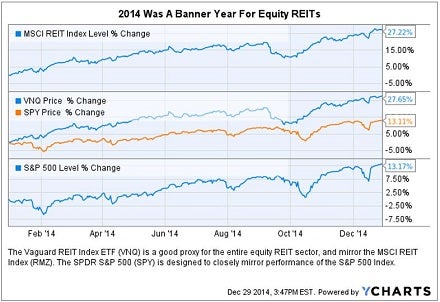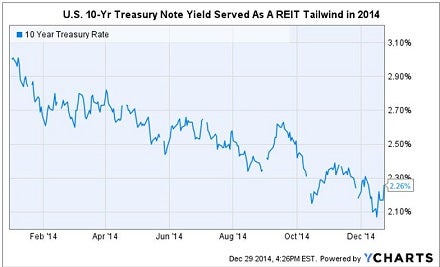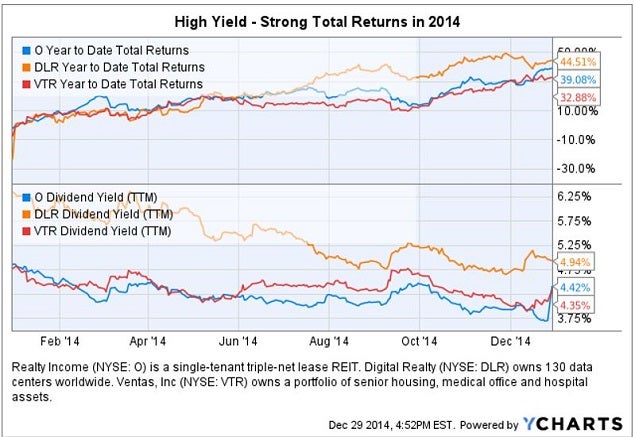The biggest REIT story of the past year did not involve the success or struggles of any one REIT.
Looking back at 2014, the biggest REIT story of the year would have to be the relative outperformance of the equity REIT asset class versus the broader market of common stocks.
One easy way to compare relative performance is to look at the Vanguard REIT Index Fund VNQ versus the SPDR S&P 500 ETF Trust SPY.

It wasn't even close.
Equity REITs performed twice as well as a relatively strong year for the S&P 500; the VNQ delivered a 27.65 percent gain.
Why Were REIT's 'Smokin' Hot?
The simple answer is that Federal Reserve accommodative monetary policy kept interest rates in check. Rather than rise during 2014, the 10-Year Treasury Note coupon rate actually fell, and remained low for the entire year.

Additional positive factors for REITs included a recovering U.S. economy, limited new development in many markets following the Great Recession, and the abundance of debt and equity capital available for commercial real estate.
Many Examples Of Strong Performance YTD
In many cases, REITs offered investors a higher dividend yield, along with significant price appreciation. Here are three illustrations:

Realty Income Corp O has a market cap of $11 billion. It owns a diverse portfolio of single-tenant properties occupied by credit-worthy tenants in business sectors such as drugstores, restaurants, and dollar stores. In addition to monthly rent, tenants pay taxes, insurance and almost all maintenance expenses.
Digital Realty Trust, Inc. DLR sports a market cap of just over $9 billion. It is currently the largest data center REIT, owning ~130 facilities worldwide. This sector is positioned to benefit from the growth of big data and cloud computing.
Ventas, Inc. VTR, with a market cap of $21.4 billion, operates in the healthcare facilities arena, including senior housing communities, medical office buildings and hospital assets. The aging of baby-boomers will be a major driver for future earnings growth.
All three of these REITs have had an excellent track-record of paying and increasing dividends to shareholders -- including during the Great Recession.
What Does This Suggest For 2015?
Investors will have to consider how low oil prices and a relatively strong U.S. economy -- tempered by the relatively poor outlook for the global economy -- will impact U.S. interest rates.
The market should also keep in mind that REITs often have increases in contract rents built into long-term leases, which can serve to increase cash available for distribution, unlike bonds that pay a fixed rate of interest.
Bottom Line
Investors who had money allocated to the four most popular REIT ETFs were able to beat the broader market in 2014, in part due to a systemic tailwind from a low interest rate environment.
However, when planning ahead for 2015, investors in equity REITs might be wise to pay closer attention to the current valuation and future prospects for different REIT sectors.
Additionally, investors looking at owning individual REIT stocks should strive to understand the differences in business strategies, asset mix, balance sheets, and perhaps most importantly of all -- the quality of management.
© 2024 Benzinga.com. Benzinga does not provide investment advice. All rights reserved.
Comments
Trade confidently with insights and alerts from analyst ratings, free reports and breaking news that affects the stocks you care about.